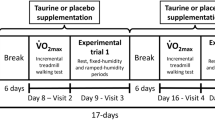Abstract
Kinetic and thermodynamic characteristics of lactate dehydrogenase (LDG) in skeletal muscles were analyzed in homeothermic animals (rats) under deep (20°C) artificial hypothermia and in heterothermic animals (ground squirrels) under natural hypothermia (hibernation). It was found that, despite different etiology of hypothermic states, changes in some LDG parameters both in homeo- and heterothermic animals at low body temperatures are unidirectional: the catalytic efficiency decreases, the optimum point on the concentration curve shifts towards higher concentrations, efficient activation energies and Ki values increase. At the same time, multidirectional changes in LDG Vmax and KM values as well as the degree of their manifestation in rats versus ground squirrels at low body temperatures indicate that the mechanisms, which regulate activity of this enzyme in animals with diverse strategies of thermal adaptation, are quite different.
Similar content being viewed by others
References
Hochachka, P. and Somero, G., Biochemical Adaptation, Oxford, 2002.
Emirbekov, E.Z. and Klichkhanov, N.K., Svobodnoradikal’nye protsessy i sostoyanie membran pri gipotermii (Free-radical Processes and the State of Membranes under Hypothermia), Rostov-on-Don, 2011.
Meilanov, I.S. and Avshalumov, M.V., Thermal compensation in homeothermic animals, Ross. Fiziol. Zh., 1997, vol. 83, no. 9, pp. 102–106.
Khalilov, R.A., Dzhafarova, A.M., Dzhabrailova, R.N., and Khizrieva, S.I., The kinetic and thermodynamic characteristics of lactate dehydrogenase in the rat brain during hypothermia, Neurochemical J., 2016, vol. 10, no. 2, pp. 156–165.
Ruf, T. and Geiser, F., Daily torpor and hibernation in birds and mammals, Biol. Rev., 2015, vol. 90, pp. 891–926.
Kalabukhov, N.I., Spyachka mlekopitayushchikh (Hibernation in Mammals), Moscow, 1985.
Carey, H.V., Andrews, M.T., and Martin, S.L., Mammalian hibernation: cellular and molecular responses to depressed metabolism and low temperature, Physiol. Rev., 2003, vol. 83, no. 4, pp. 1153–1181.
Khalilov, R.A., Meilanov, I.S., and Dzhafarova, A.M., A study of the kinetic charatceristics of lactate dehydrogenase in gastrocnemius muscles of ground squirrels during hibernation and in the dynamics of induced warming, Vestn. DNTs RAN, 2012, iss. 46, pp. 40–44.
Khalilov, R.A., Dzhafarova, A.M., and Dzhabrailova, R.N., A study of temperature dependence of lactate dehydrogenase in muscles of ground squirrels during hypothermia, Vestn. DGU, iss. 6, pp. 114–119.
Lowry, D.H., Rosembrough, H.J., and Farr, A.L., Protein measurement with the Pholin phenol reagent, J. Biol. Chem., 1951, vol. 193, pp. 265–275.
Zakhartsev, M., Johansen, T., Portner, H.O., and Blust, R., Effects of temperature acclimation on lactate dehydrogenase of cod (Gadus morhua): genetic, kinetic and thermodynamic aspects, J. Exp. Biol., 2004, vol. 207, pp. 95–112.
Oda, T., Shimizu, K., Yamaguchi, A., Satoh, K., and Matsumoto, K., Hypothermia produces rat liver proteomic changes as in hibernating mammals but decreases endoplasmic reticulum chaperones, Cryobiol., 2012, vol. 65, pp. 104–112.
Katzenback, B.A., Dawson, N.J., and Storey, K.B., Purification and characterization of a urea sensitive lactate dehydrogenase from the liver of the African clawed frog, Xenopus laevis, J. Comp. Physiol., 2014, vol. 184, pp. 601–611.
Fan, J., Hitosugi, T., Chung, T., Xie, J., Ge, Q., Gu, T., Polakiewicz, R., et al., Tyrosine phosphorylation of lactate dehydrogenase a is important for NADH/NAD+ redox homeostasis in cancer cells, Mol. Cell. Biol., 2011, vol. 31, no. 24, pp. 4938–4950.
Forlemu, N., Njabonl, E., Carlson, K., Schmidt, E., Waingeh, V., and Thomasson, K., Ionic strength dependence of F-actin and glycolytic enzyme associations: a Brownian dynamics simulations approach, Proteins, 2011, vol. 79, no.10, pp. 2813–2827.
Terao, Y., Miyamoto, S., Hirai, K., Kamiguchi, H., Ohta, H., Shimojo, M., Kiyota, Y., Asahi, S., Sakura, Y., and Shintani, Y., Hypothermia enhances heat-shock protein 70 production in ischemic brains, Neuroreport., 2009, vol. 20, no. 8, pp. 745–749.
Peng, H.L., Deng, H., Dyer, R.B., and Callender, R., Energy landscape of the Michaelis complex of lactate dehydrogenase: relationship to catalytic mechanism, Biochem., 2014, vol. 53, pp. 1849–1857.
Pastukhov, Yu.F., Nevredinova, Z.G., and Slovikov, B.I., Annual budget of activity and energy costs in hibernating mammals, Dokl. Akad. Nauk SSSR, 1989, vol. 305, pp. 1270–1273.
Cantó, C., Gerhart-Hines, Z., Feige, J.N., Lagouge, M., Noriega, L., Milne, J.C., Elliott, P.J., Puigserver, P., and Auwerx, J., AMPK regulates energy expenditure by modulating NAD+ metabolism and SIRT1 activity, Nature, 2009, vol. 458, pp. 1056–1060.
Vermillion, K.L., Anderson, K.J., Hampton, M., and Andrews, M.T., Gene expression changes controlling distinct adaptations in the heart and skeletal muscle of a hibernating mammal, Physiol. Genomics, 2015, vol. 47, pp. 58–74.
Cotton, C.J., Skeletal muscle mass and composition during mammalian hibernation, J. Exp. Biol., 2016, vol. 219, pp. 226–234.
Bell, R.A., Smith, J.C., and Storey, K.B., Purification and properties of glyceraldehyde-3-phosphate dehydrogenase from the skeletal muscle of the hibernating ground squirrel, Ictidomys tridecemlineatus, Peer J., 2014, vol. 2. doi 10.7717/peerj.634
Hardie, D.G., Hawley, S.A., and Scott, J.W., AMP activated protein kinase development of the energy sensor concept, J. Physiol., 2006, vol. 574, no. 1, pp. 7–15.
Shikhamirova, Z.M., Ismailova, Zh.G., Astaeva, M.D., and Klichkhanov, N.K., Free-radical processes in synaptosomes of the ground squirrel brain during hibernation and awakening, Est. Nauki, Zh. Fund. Prikl. Issled., 2012, vol. 38, no. 1, pp. 213–218.
Author information
Authors and Affiliations
Corresponding author
Additional information
Original Russian Text © R.A. Khalilov, A.M. Dzhafarova, S.I. Khizrieva, V.R. Abdullaev, 2018, published in Zhurnal Evolyutsionnoi Biokhimii i Fiziologii, 2018, Vol. 54, No. 6, pp. 413–420.
Rights and permissions
About this article
Cite this article
Khalilov, R.A., Dzhafarova, A.M., Khizrieva, S.I. et al. Kinetic and Thermodynamic Characteristics of Lactate Dehydrogenase in Skeletal Muscles of Homeo- and Heterothermic Animals at Low Body Temperatures. J Evol Biochem Phys 54, 465–473 (2018). https://doi.org/10.1134/S0022093018060066
Received:
Revised:
Accepted:
Published:
Issue Date:
DOI: https://doi.org/10.1134/S0022093018060066




